Abstract
The educational system in Nigeria in this 21st century is at crossroads. In recent time, the teacher education has been increasingly lampooned by stakeholders accusing it of not meeting the demands of this century. This informed the researchers to examine if teacher education in Nigeria is on course by looking at the extent 21st century skills are emphasized in teacher education and the extent student teachers perceive themselves to have acquired these skills in the course of their training. The mixed method design was adopted. 194 regular students in Faculties of Education in two state owned universities in Anambra State were sampled using a nonrandom convenience sampling technique. Data were collected using questionnaire and semi-structured interview; and were analyzed. Findings revealed that, to some extent, the 21st century skills were emphasized and were perceived to be possessed by respondents. Data from the interview helped to deepen the understanding of the problem. It was concluded that though these skills are perceived to be emphasized and acquired to some extent; that more complex ones are yet to be properly infused in the teaching and learning process.
Keywords: 21 century skillsteacher educationtechnologydigital age
1.Introduction
The digital age revolution has permeated the classroom and has reoriented stakeholders in new
methods with which children are to be handled, the content of instruction and the skill-set to be imparted
on the students. Research findings show that in America as far back as 10 years ago that ‘21% of all
children aged 2 years and younger, 58% of 3- to 4-year-olds, and 77% of 5- to 6-yearolds have had some
experience with computers, often on a daily basis’ (Calvert, Rideout, Woolard, Barr, &Strouse, 2005 as
cited in Shamir, 2013, p. 96). Furthermore, Shamir (2013, p. 96) noted that a survey study by Roberts
(2011) ‘found that children aged 2–5 years are often more adept at playing video games and downloading
computer applications than at tying their shoelaces or riding a bike’ [and] that ‘these findings are reflected
in the marketplace, with iPhones, iPods, and iPads increasingly being sold as gifts for children aged 6–12
years; fake plastic cellphones are sought for toddlers aged about 2 years. On the other hand, the
adolescents have been described as being excessively consumed in their technological world engaging in
several online discussions almost at the same time and always (Taffel, nd) and, to many teachers are now
addicted.
The above scenario has called for a change in the way children are taught and the skills they need
to acquire in school so that their interest could be sustained and they will be able to survive in the
technological age (Shamir, 2010; Barell, 2010; Dede, 2010; Gardener, 2010). Ledward and Hirata
(2011:1) see the 21st Century Skills as encompassing ‘several inter-related skill sets: life and career
skills; learning and innovation skills; information, media, and technology skills; and core-subject mastery
and familiarity with interdisciplinary themes’. Hixson, Ravitz and Whisman (2012) after extensive
literature operationalized and developed an inventory to measure technology as tool of learning skills,
critical thinking skills, collaborative skills, communication skills, creativity and innovative skills, self-
regulated skills, global and local connections skills.
Experts have noted that for educational system to be relevant, there is the need that it moves along
and gets adapted to societal changes in such a way that its products will be able to fit into the society. It
looks as if the teacher education in Nigeria lags behind in integrating the changes in society to what goes
on in the classroom; and little wonder it has been lampooned, criticized and gaps have been picked in its
operations (Ijaiya, 2008; Adeyanju, 2008; Ikeotuonye, 2011; Independent commission for Aid Impact
(ICAI); 2012). Olibie and Akudolu (2007) identified creativity as a gap in practices inherent in Nigerian
universities’ classrooms while the study by Nwite (2011) in recognition of the NUC benchmark that ICT
literacy should be made integral in teacher education showed that many Faculty members are yet to be
computer literate. This is against the backdrop that there are policies geared towards integrating the 21st
century skills in the teacher education in Nigeria. Apart from the ICT skills, there has been advocates for
new ways of imparting knowledge and skills that will enable students to become efficient workforce in
the 21st century. Though there have been studies focused on ICT skills, awareness, and use among
teachers, there seems to be a gap in determining the extent teacher trainees perceive their learning
experiences to be in compliance with the 21st century demands. The following research questions were
asked: (a) To what extent are the 21st century skills emphasized in teacher education programme in
Nigeria? (b) To what extent do student teachers perceive themselves to have acquired these skills in the
course of their training?
2. Methodology
The researchers adopted a mixed method which involves a conglomeration of quantitative and
qualitative methods as components of a research work which paves way for better understanding of the
research problem (Ponce, & Pagán-Maldonado, 2015). Data collection involved the use of questionnaire
and semi-structured interview. The population of the study consisted of student teachers in the Faculties
of Education in two state owned universities in Anambra State, Nigeria. These students are trainee
teachers in 2014/2015 academic session. The sample size is 194 regular student teachers. A nonrandom
convenience sampling technique was adopted given the fact that those who were sampled were students
who gave their consent to participate in the study. 35.05% were male, 64.43% female and .52% were
unidentified students. 6.70% specialized in science education, 49.48% in social science education and
43.81% in arts education. 5.67% were in year one, 10.31% in year two, 66.50% in year three and 17.53 in
year four.
Questionnaire and interview were used. The questionnaire is a modification of that of developed
Hixson, Ravitz, and Whisman (2012) used to assess 21st century teaching and learning. Though it was
initially used on teachers to assess how their teaching impact on 21st century skills, it was restructured to
measure the extent student teachers in Nigeria perceived these skills to be emphasized in the course of
their training and the extent they have acquired these skills. The instrument was validated by experts in
teacher education and education technology. It consists of 37 items of 3 subscales each subscale is made
up 2 subsets. A semi-structured interview was used to get in-depth understanding of the problem under
study. Respondents’ original names were not used rather they were coded as 1/m/400 (1st interviewee,
male student in 4th year), 2/m/400 (2nd interviewee, male student in 4th year), 3/f/300 (3rd interviewee,
female student in 3rd year), and 4/f/300 (4th interviewee, female student in 3rd year). Percentage and
mean were used in the analysis and the interview was qualitatively analyzed. In order to take decision, the
real limits were adopted: Not at all (1-1.44); A little (1.45-2.44); some extent (2.45-3.44); very much
extent (3.45-4.00) abbreviated respectively as NA, AL, SE, and VME.
3. Results
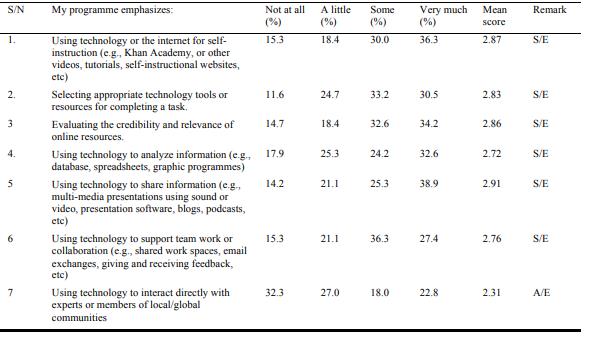
Table 1 above presented student teachers’ mean/percentage responses on the emphasis laid on
technology as a tool for learning in the course of their training. All the items in table one, looking at their
mean scores, were perceived to be emphasized to some extent with the exception of item 7 which has to
do with the use of technology to interact with experts in their field of study. Combining some and very
much extent scales in the 8 items, a range of 60 to 64.2% of the respondents agree that they are
emphasized except item 7 that recorded 40.8%.
The qualitative data from the interview gave an insight to the direction of emphasis which was
mainly on creating awareness and encouraging students to search material for assignment online:
reasonable extent…I would say my field,… have to a greater extent emphasized the use of technology.
Most researches, assignments are centered on the use of internet. Even lecturers advocate for the use of
internet for further studies’ (1/m/400). ‘….We have E-view econometrics, some software in running
econometric figures. So there are some kinds of technologies that are being used in getting the knowledge
in economics particularly…’ (2/m/400).‘I think great emphasis is laid on the use of technology during
our course of training. Most times, lecturers will tell you to go search information in the internet’
(3/f/300).
Furthermore, variety of technology was not emphasized and proper integration into their studies in
the classroom may be lacking: ‘…but we don’t use variety of media (4/f/300). ‘…the Khan academy is
alien to me’(3/f/300). ‘…these facilities are found in economics department but the way students are
taught there is not encouraging. For example, students who carry out researches go outside to meet
experts that run it for them, due to lack of knowledge of what they have been taught in class’ (2/m/400).
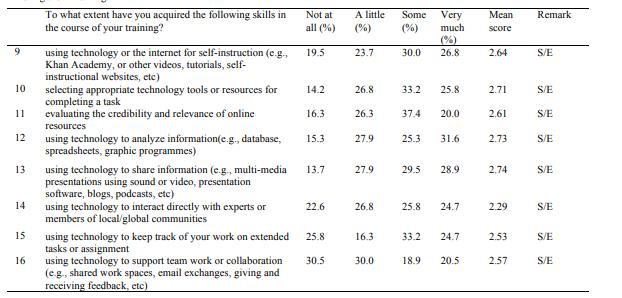
Table 2 above shows the mean indicated that to some extent, student teachers perceived
themselves as possessing these skills. When the ‘some and very much extent scales’ are added together, a
range of 50.5 to 58.4% of the respondents agree that they have acquired the skills.
Though, data from the interview revealed that students perceived themselves as having acquired
the skill of technology as tool for learning, it indicated that it may be a mixture of the emphasis and extra
efforts made by them outside what obtains in the course of their learning:
the acquisition of knowledge in technology. There is no kind of encouragement on the use of technology’
(2/m/400). ‘No … because the environment is not enabling. Though, recently part of assignment entailed
burning information gathered in a disc that is converted to software…. the training alone is not enough.
It requires extra work on your own’ (3/f/300).

Table 3 above shows the mean/percentage responses of student teachers on their perceived
emphasis on collaborative skills in the course of their programme. Analysis of the data using mean
indicated that to some extent these skills are emphasized in the course of their training. Percentage
responses range between 45.2 and 78.9% when the some extent and very much extent are summed
together.
Furthermore, data from the interview revealed that emphasis were in the areas of completing a task
jointly, working together to set a plan and create a planning, creation of joint products, and joint
presentations of work. Responses were, however, silent on peer assessment and feedback:
program has emphasized greatly on this because, we learn more when we do collaborative work… For
instance, our project was not an individual task. We shared ideas and combined them to produce a
work… Microteaching where we were asked to create some things…was a group project. We joined
hands together, our money and produced something’ (1/m/400). ‘That is the part my department has done
classically well. For example, our projects are done in pairs just to ascertain how you relate and
coordinate and come up with solutions’ (2/m/400). ‘Yes,… Most of our assignments are done in groups
and it entails brainstorming with your group and present it in groups, generate information and ideas.
Most times, even though grades are individualized they are also graded based on the overall performance
of the group. So I … applaud … that’ (3/f/300).‘Very well…, you have to be outstanding… outspoken,
work in groups in order to bring out an output. Most times, individuals work in a groups. When we do,
students will be able to learn from each other’ (4/f/300).
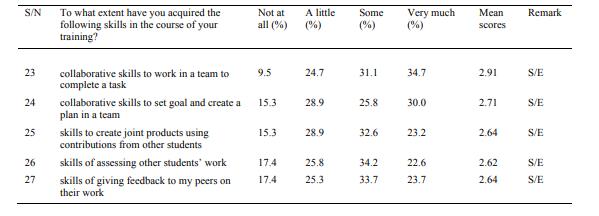
Table 4 above shows student teachers’ mean/percentage responses on their perceived acquisition
of skills on collaborative skills during the course of their training. Analysis of the data, using mean
statistic, shows that student teachers to some extent perceived themselves to have acquired collaborative
skills in the course of their training. Percentage responses of students who agreed that they have acquired
these skills range between 65.8% and 56.8% when the some extent and very much extent scales are
summed together.
Concerning the acquisition of collaborative skills, qualitative data showed that students perceive
themselves to have acquired those skills, more especially skills that make it possible people to work as a
team: ‘…being democratic in working in groups’ (2/m/400) ‘Ability to express myself in public, in
gatherings, which entail being able to communicate with people, sustaining people’s interest while
talking to them’ (3/f/300). ‘I can say I … able to be confident without having to fidget in a group because
we have been doing it with my lecturers and course mates’ (4/f/300).
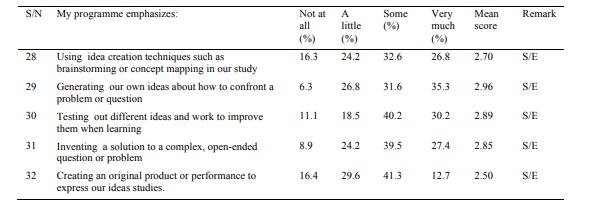
Table 5 showed the mean/percentage responses of student teachers on the perceived emphasis on
creativity and innovation skills in the course of their training. Mean response scores indicated that all the
five items are emphasized to some extent. Percentage of agreement ranges from 54.0 to 66.9%.
Data from the interview showed that although the skills were emphasized they were not taught as
explicit as they ought to be and depended on lecturers’ ability:
new methods. For instance if you want to teach students about certain crisis happening in a particular
environment, you don’t just start that by telling them stories of such crisis. You can also think about an
idea, like how to present this in a pictorial view’ (1/m/400). ‘Yes… but not like it should. Like in a course
we did, we were grouped…to produce something. Though the program is there, it did not convey the
concept of creativity and innovation’ (2/m/400). ‘My program [emphasized] these skills to an extent. Due
to the fact that lecturers have varying degrees of asking questions, it tends to be limited. Some of them
will ask you questions that do not have definite answers. Through that you will be able to express your
thoughts, think out, and be creative’ (3/m/300). ‘Yes, most times in class when a question is asked, the
lecturers do not expect one person to answer the question. They expect everyone to think and bring up
their different ideas’ (4/m/300).
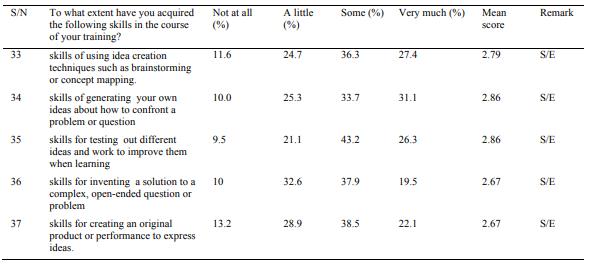
Table 6 showed that mean responses of the students indicated that they perceived themselves to
have acquired the skills of creativity and innovation to some extent. Percentage agreement ranges from
60.6 and 69.5%.
Students, through the analysis of the qualitative data, perceived themselves to have acquired these
skills to some extent, especially in creating their own products and solution to open ended questions:
‘….the ability to bring to life, whatever I am communicating to my students, not just making them hear it
but visualizing it and feeling it. Maybe through paintings, emotion pictures etc’ (1/m/400) ‘we apply
improvisation where we get materials from our environment…. Through my program, I am able to
improvise towards solving my immediate problems’ (2/m/400).
3. Discussion
Findings revealed that on technology as a tool for learning, it is, to some extent, emphasized in
teacher training except when it had to do with interacting with experts in local or global communities.
This may indicate an increasing adoption of technology in the teaching and learning situation in Nigeria
in recent time, contrary to previous findings related to awareness and availability of ICT facilities in
Nigerian universities which rated them low (Danner & Pessu, 2013; Denwigwe, 2015). However,
qualitative data indicated the limit and direction of the emphasis bringing out the fact that variety of
technology were not emphasized which could be attributed to low ICT facilities in Nigerian universities
(Egoeze, Misra, Akman & Colomo-Palacios 2014). To some extent, student teachers perceived that they
have acquired the skills for the use of technology as a tool for learning. The qualitative data showed that it
may be as a result of both the emphasis laid on it and the extra efforts students make outside their
classrooms to acquire these skills since the technology was not appropriately integrated in their classroom
activities. The issue of not being appropriately integrated in classroom activities might have been a result
of limited knowledge of their teachers in the use of the technology in teaching and learning (Denwigwe,
2015; Nwite, 2011). Policies and implementation strives in developing nations, Nigeria inclusive, have
revolved within the peripheral ambits of implementation of ICT, and have not exceeded the practical
levels of infusing and applying more sophisticated technologies in teacher education (Olakulehin, 2007).
Findings on emphasis on collaborative skills in the course of their training showed that it is emphasized to some extent. This is because these skills are indispensable in teacher education in the 21st
century (Zygouris-Coe, 2012) and challenges arising in society may not be easily conquered by an
individual alone. The complex challenges that arise as a result of the influx of information brought about
ICT facilities require the coming together of individuals to work as a team to unravel these challenges.
The findings revealed that student teachers were encouraged to collaboratively work on their assignments,
projects, etc. to build in them the team spirit needed in this century. They perceived themselves to have
acquired these skills but in the qualitative data, the issue of peer assessment was very silent confirming
the relatively low rating of peer assessment related items in the quantitative data.
In creativity and innovation skills teacher trainees stated that these skills are emphasized in their
training and that they have acquired the skills to some extent. They agree that open-ended questions are
asked, brainstorming, coming up with new ideas to confront immediate problems, improvisation for
solution of immediate problem, etc. are emphasized. This finding contradicts the findings of Eyiuche and
Akudolu (2007) who reiterated that creativity is a blind spot in teacher education in Nigeria. This
contradiction might have resulted because of the fact that Eyiuche and Akudolu focused on the
instructional methods adopted to foster these skills in students and not necessarily if they are emphasized.
They stated that lecturers did not use variety of learning experiences to encourage creativity. This could
be untangled looking at the qualitative data which revealed that students perceived that these skills are not
integrated in their studies as they should. So the method of instructed should be improved upon for better
acquisition.
4. Conclusion
The study examined the extent teacher education in Nigeria is in line with the skills of the 21st
century by looking at the perception of student teachers on the emphasis and their acquisition of the skills
in the course of their training. Across the skills, student teachers perceived that these skills are
emphasized to some extent except for very few sub-skills. Skills that are accomplished with the use of
more sophisticated technologies were rated low by student teachers and through the qualitative data,
respondents emphasized that a lot needs to be done in integrating these skills in their learning. It was
concluded that the teacher education in Nigeria could not be said to be completely out of tune with the
demands of the 21st century that what needs to be done is to properly integrate these skills in classroom
practices. Though there is paucity of research that have looked into these skills among teacher trainees in
our universities, it is suggested that more robust research using other methods and larger sample size be
conducted and that there should be: (1) intensive training and retraining of teacher educators in Nigeria on the demands and skills of the 21st century; (2) efforts made by stakeholders to restructure the curriculum
for teacher trainees to acquire these skills by explicitly and implicitly teaching these skills; (3) provision
of variety of technologies in teacher education institutes should be a priority to the government of
Nigeria.
References
- Adeyanju, T. K. (2009). Training and utilization of primary school teachers in Nigeria. A paper
- presented at the Nigerian Academy of Education Seminar.
- Barell, J. (2010). Problem-based learning: The foundation of 21st century skills. In J. Bellanca, & R.
- Brandt, (Eds).21st century skills: Rethinking how students learn (pp. 175-199). Bloomington, IN: Solution Tree Press.
- Danner, R. B. & Pessu, C. O. A. (2013). A survey of ICT competencies among students in teacher preparation programmes at the University of Benin, Benin City, Nigeria. Journal of Information Technology Education: Research,12, 2013, 33-49. Retrieved from http://www.jite.org/documents/Vol12/JITEv12ResearchP033-049Danner1160.pdf
- Dede, C. (2010). Comparing frameworks for 21st century skills. In J. Bellanca, & R. Brandt, (Eds).21st
- century skills: Rethinking how students learn (pp. 51-75). Bloomington, IN: Solution Tree Press.
- Denwigwe, C. P. (2015). Trainee teachers’ acceptance of integration of information communication technology in lesson delivery in College Of Education, Zuba, Nigeria: Counselling implications. Asia Pacific Journal of Multidisciplinary Research, 3 (2), 98-105.
- Egoeze, F., Misra, S., Akman, I. &Colomo-Palacios, R. (2014). An evaluation of ICT infrastructure and application in Nigeria Universities. Acta Polytechnica Hungarica, 11(9), 115-129.
- Hixson, N., Ravitz, J. &Whisman, A. (2012). Extended professional development in project-based
- learning: Impacts on 21st century teaching and students achievement. Charleston, WV: West Virginia Department of Education. Retrieved from https://www.academia.edu/1999374.
- Ikeotuonye, A. I. (2011). Preparing teachers for the challenges of Nigerian vision. In B. G. Nworgu and J.
- C. Buseri (Eds). Human development for vision 20-2020. Abuja: National Educational Research and Development Council (NERDC).
- Independent Commission for Aid Impact (ICAI)(2012). DFID’s education programmes in Nigeria.
- Report 16, November, 2012. Retrieved from https://icai.independent.gov.uk/wp-content/uploads/ICAI-Nigeria-Education-report.pdf Ledward, B. C., & Hirata, D (2011). An overview of 21st century skills. Summary of 21st Century Skills for Students and Teachers. Pacific Policy Research Center, Honolulu: Kamehameha Schools–Research & Evaluation. Retrieved from http://www.ncrel.org/engauge/skills/skills.htm Nwite, O. (2011). Teacher preparation and information and communication technology (ICT) in Ebonyi State University for the challenges of vision 20-2020. In B. G. Nworgu and J. C. Buseri (Eds).
- Human development for vision 20-2020. Abuja: National Educational Research and Development Council (NERDC).
- Olakulehin, F. K. (2007). Information and communication technologies in teacher training and professional development in Nigeria. Turkish Online Journal of Distance Education, 8 (1), 133-142. Retrieved from http://www.acarindex.com/dosyalar/makale/acarindex-1423932378.pdf
- Olibie, E. I. &Akudolu, L-R. I. (2007). Creativity: A blind spot in quality teacher education in Anambra
- State. In E. Eke and Ayodele-Bamisaiye (Eds.). Blind spots in the Nigerian Educational System. The Nigerian Academy of Education, 22nd annual congress proceedings held at Ibadan.
- Ponce, O. A. & Pagán-Maldonado, N. (2015). Mixed methods research in education: Capturing the complexity of the profession. International Journal of Educational Excellence, 1(1), 111-135.
- Retrieved from http://www.suagm.edu/umet/ijee/pdf/1_1/ponce_pagan_maldonado_ijee_1_1_111-135.pdf Shamir (2013).Cognitive education in the digital age: Bridging the gap between theory and practice.
- Journal of Cognitive Education and Psychology, 12 (1), 96-107. DOI: 10.1891/1945-8959.12.1.6.
- Zygouris-Coe, V. (2012). Collaborative learning in an online teacher education course: Lessons learned.
- ICICTE
Copyright information

This work is licensed under a Creative Commons Attribution-NonCommercial-NoDerivatives 4.0 International License.
About this article
Publication Date
25 May 2017
Article Doi
eBook ISBN
978-1-80296-022-8
Publisher
Future Academy
Volume
23
Print ISBN (optional)
-
Edition Number
1st Edition
Pages
1-2032
Subjects
Educational strategies, educational policy, organization of education, management of education, teacher, teacher training
Cite this article as:
ChinazaNwosu, K., ChidiUnachukwu, G., Achukwu, C. B., & ObyUzoechina, G. (2017). Teacher Education In Nigeria: A Misfit In The Digital Age?. In E. Soare, & C. Langa (Eds.), Education Facing Contemporary World Issues, vol 23. European Proceedings of Social and Behavioural Sciences (pp. 320-329). Future Academy. https://doi.org/10.15405/epsbs.2017.05.02.40

